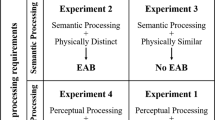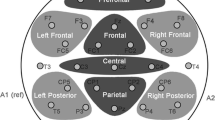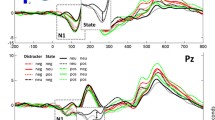Abstract
The present experiments were designed to examine the influences of picture duration, task relevance, and affective content on neural measures of sustained engagement, as indexed by the late positive potential (LPP). Much prior work has shown that the event-related potential in and around the P3—here referred to as the early LPP—is modulated by affective content, nonaffective task relevance, and stimulus duration. However, later portions of the LPP (>1,000 ms) may represent either a return to baseline or a continued physiological process related to motivational engagement. In the present experiments, we tested whether modulation of the later LPP depends on varying motivational engagement using stimulus duration, affective content, and task relevance. The results of Experiment 1 revealed that stimulus duration modulates the sustained LPP (i.e., 1,000–2,000 ms) in response to affective, but not task-relevant, stimuli from a modified counting oddball task. The results of Experiment 2 revealed that the sustained increase in the LPP is sensitive to both emotional content and task relevance when the task requires sustained engagement with target stimuli (e.g., determining the duration of stimulus presentation). The impacts of emotional content and task relevance had additive effects on the later portion of the LPP. In sum, both emotional content and task relevance can result in a protracted increase in the later LPP. These data suggest that affective content automatically sustains engagement, whereas task relevance only prolongs engagement when it is necessary for task completion.




Similar content being viewed by others
Notes
The particular IAPS stimuli used were as follows: neutral target = 2102, neutral = 2383, pleasant = 4608, and unpleasant = 6250.
A 2 (Valence: pleasant vs. unpleasant) × 2 (Duration: short vs. long) × 2 (Time Window: early vs. late) repeated measures analysis of variance (ANOVA) revealed no main effect of valence, F(1, 38) = 0.01, p = .925, η p 2 < .01, and the overall interaction of valence, duration, and time window was nonsignificant, F(1, 38) = 2.10, p = .156, η p 2 = .05. Because unpleasant versus pleasant valence did not have a main effect or interaction, affective stimuli were combined in subsequent analyses.
The early time window in the short display condition includes the offset event-related potential evoked by picture display ending. Differences between the short and long picture durations in the early time window were likely due to the potential evoked by picture offset.
Stimuli were again drawn from the IAPS (Lang et al., 2008): neutral targets = 2357, 2381, 2393, 2480, 2870; unpleasant targets = 3016, 3051, 3101, 3102, 3120; pleasant targets = 4608, 4623, 4626, 4660, 4689; and neutral standards = 2191, 2383, 2385, 2396, 2840.
As in Experiment 1, a 2 (Valence: pleasant vs. unpleasant block) × 2 (Task Relevance: target vs. standard) × 2 (Time Window: early vs. late) revealed no main effect of valence, F(1, 15) = 2.14, p = .163, η p 2 = .13, and the overall interaction of valence, target/standard, and time window was also nonsignificant, F(1, 15) = 0.61, p = .447, η p 2 = .04. Because unpleasant versus pleasant valence did not have a main effect or interaction, affective stimuli were combined in the further analyses.
The mean correct identification of short-duration targets was 85.7%, whereas the mean correct identification of long-duration targets was 85.4%.
References
Codispoti, M., Ferrari, V., & Bradley, M. M. (2006). Repetitive picture processing: Autonomic and cortical correlates. Brain Research, 1068, 213–220. doi:10.1016/j.brainres.2005.11.009
Cousineau, D. (2005). Confidence intervals in within-subject designs: A simpler solution to Loftus and Masson’s method. Tutorial in Quantitative Methods for Psychology, 1, 42–45.
Cuthbert, B. N., Schupp, H. T., Bradley, M. M., Birbaumer, N., & Lang, P. J. (2000). Brain potentials in affective picture processing: Covariation with autonomic arousal and affective report. Biological Psychology, 52, 95–111. doi:10.1016/S0301-0511(99)00044-7
Dunning, J., & Hajcak, G. (2009). See no evil: Directing visual attention within unpleasant images modulates the electrocortical response. Psychophysiology, 46, 28–33.
Ferrari, V., Bradley, M. M., Codispoti, M., & Lang, P. J. (2010). Detecting novelty and significance. Journal of Cognitive Neuroscience, 22, 404–411. doi:10.1162/jocn.2009.21244
Ferrari, V., Codispoti, M., Cardinale, R., & Bradley, M. M. (2008). Directed and motivated attention during processing of natural scenes. Journal of Cognitive Neuroscience, 20, 1753–1761. doi:10.1162/jocn.2008.20121
Foti, D., Hajcak, G., & Dien, J. (2009). Differentiating neural responses to emotional pictures: Evidence from temporal–spatial PCA. Psychophysiology, 46, 521–530. doi:10.1111/j.1469-8986.2009.00796.x
Franken, I. H., Nijs, I., & Pepplinkhuizen, L. (2008). Effects of dopaminergic modulation on electrophysiological brain response to affective stimuli. Psychopharmacology, 195, 537–546.
Gable, P. A., & Adams, D. L. (2013). Non-affective motivation modulates the sustained LPP (1, 000–2,000 ms). Psychophysiology, 12, 1251–1254.
Gable, P. A., & Harmon-Jones, E. (2010). The effect of low versus high approach-motivated positive affect on memory for peripherally versus centrally presented information. Emotion, 10, 599–603. doi:10.1037/a0018426
Gable, P. A., & Poole, B. D. (2012). Influence of trait behavioral inhibition and behavioral approach motivation systems on the LPP and frontal asymmetry to anger pictures. Social Cognitive and Affective Neuroscience, 9, 182–190. doi:10.1093/scan/nss130
Hajcak, G., Dunning, J., & Foti, D. (2009). Motivated and controlled attention to emotion: Time-course of the late positive potential. Clinical Neurophysiology, 120, 505–510.
Hajcak, G., & Olvet, D. M. (2008). The persistence of attention to emotion: Brain potentials during and after picture presentation. Emotion, 8, 250–255. doi:10.1037/1528-3542.8.2.250
Ito, T. A., & Cacioppo, J. T. (2000). Electrophysiological evidence of implicit and explicit categorization processes. Journal of Experimental Social Psychology, 36, 660–676.
Keil, A., Müller, M., Gruber, T., Wienbruch, C., Stolarova, M., & Elbert, T. (2001). Effects of emotional arousal in the cerebral hemispheres: A study of oscillatory brain activity and event-related potentials. Clinical Neurophysiology, 112, 2057–2068.
Kok, A. (2001). On the utility of P3 amplitude as a measure of processing capacity. Psychophysiology, 38, 557–577.
Lang, P. J., Bradley, M. M., & Cuthbert, B. N. (2008). International Affective Picture System (IAPS): Affective ratings of pictures and instruction manual (Technical Report No. A-8). Gainesville, FL: University of Florida, Center for Research in Psychophysiology.
Moratti, S., Saugar, C., & Strange, B. A. (2011). Prefrontal-occipitoparietal coupling underlies late latency human neuronal responses to emotion. Journal of Neuroscience, 31, 17278–17286.
Pastor, M. C., Bradley, M. M., Löw, A., Versace, F., Moltó, J., & Lang, P. J. (2008). Affective picture perception: Emotion, context, and the late positive potential. Brain Research, 1189, 145–151. doi:10.1016/j.brainres.2007.10.072
Sabatinelli, D., Keil, A., Frank, D. W., & Lang, P. J. (2013). Emotional perception: Correspondence of early and late event-related potentials with cortical and subcortical functional MRI. Biological Psychology, 92, 513–519. doi:10.1016/j.biopsycho.2012.04.005
Schupp, H. T., Cuthbert, B. N., Bradley, M. M., Hillman, C. H., Hamm, A. O., & Lang, P. J. (2004). Brain processes in emotional perception: Motivated attention. Cognition and Emotion, 18, 593–611.
Semlitsch, H. V., Anderer, P., Schuster, P., & Presslich, O. (1986). A solution for reliable and valid reduction of ocular artefacts, applied to the P300 ERP. Psychophysiology, 23, 695–703. doi:10.1111/j.1469-8986.1986.tb00696.x
Weinberg, A., Ferri, J., & Hajcak, G. (2013). Interactions between attention and emotion: Insights from the late positive potential. In M. D. Robinson, E. R. Watkins, & E. Harmon-Jones (Eds.), Handbook of cognition and emotion (pp. 35–54). New York, NY: Guilford Press.
Weinberg, A., & Hajcak, G. (2011). The late positive potential predicts subsequent interference with target processing. Journal of Cognitive Neuroscience, 23, 2994–3007. doi:10.1162/jocn.2011.21630
Weinberg, A., Hilgard, J., Bartholow, B., & Hajcak, G. (2012). Emotional targets: Evaluative categorization as a function of context and content. International Journal of Psychophysiology, 84, 149–154. doi:10.1016/j.ijpsycho.2012.01.023
Author information
Authors and Affiliations
Corresponding author
Rights and permissions
About this article
Cite this article
Gable, P.A., Adams, D.L. & Proudfit, G.H. Transient tasks and enduring emotions: the impacts of affective content, task relevance, and picture duration on the sustained late positive potential. Cogn Affect Behav Neurosci 15, 45–54 (2015). https://doi.org/10.3758/s13415-014-0313-8
Published:
Issue Date:
DOI: https://doi.org/10.3758/s13415-014-0313-8




